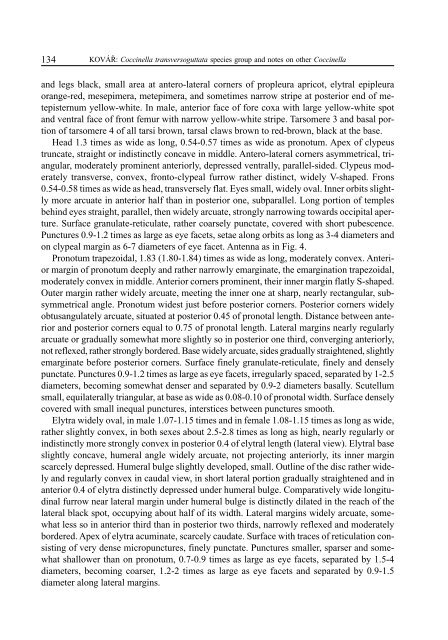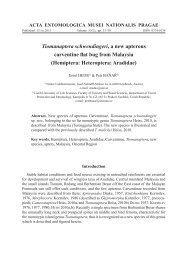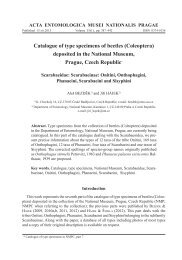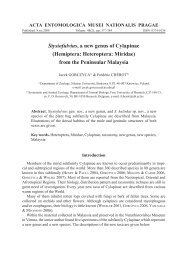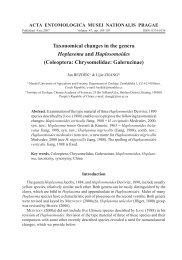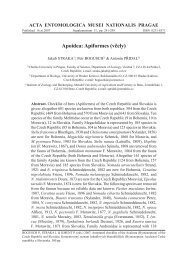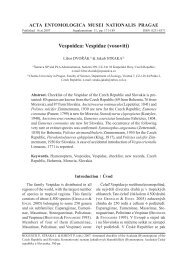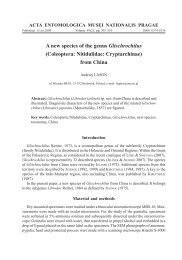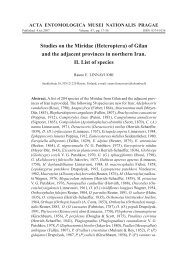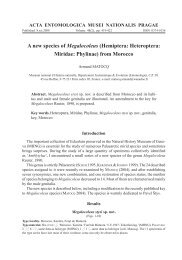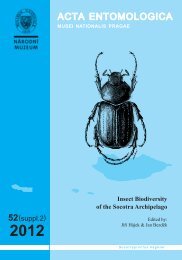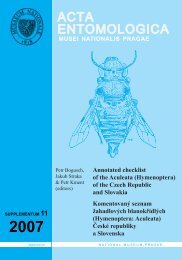Revision of the Palaearctic species of the Coccinella ...
Revision of the Palaearctic species of the Coccinella ...
Revision of the Palaearctic species of the Coccinella ...
You also want an ePaper? Increase the reach of your titles
YUMPU automatically turns print PDFs into web optimized ePapers that Google loves.
134<br />
KOVÁŘ: <strong>Coccinella</strong> transversoguttata <strong>species</strong> group and notes on o<strong>the</strong>r <strong>Coccinella</strong><br />
and legs black, small area at antero-lateral corners <strong>of</strong> propleura apricot, elytral epipleura<br />
orange-red, mesepimera, metepimera, and sometimes narrow stripe at posterior end <strong>of</strong> metepisternum<br />
yellow-white. In male, anterior face <strong>of</strong> fore coxa with large yellow-white spot<br />
and ventral face <strong>of</strong> front femur with narrow yellow-white stripe. Tarsomere 3 and basal portion<br />
<strong>of</strong> tarsomere 4 <strong>of</strong> all tarsi brown, tarsal claws brown to red-brown, black at <strong>the</strong> base.<br />
Head 1.3 times as wide as long, 0.54-0.57 times as wide as pronotum. Apex <strong>of</strong> clypeus<br />
truncate, straight or indistinctly concave in middle. Antero-lateral corners asymmetrical, triangular,<br />
moderately prominent anteriorly, depressed ventrally, parallel-sided. Clypeus moderately<br />
transverse, convex, fronto-clypeal furrow ra<strong>the</strong>r distinct, widely V-shaped. Frons<br />
0.54-0.58 times as wide as head, transversely flat. Eyes small, widely oval. Inner orbits slightly<br />
more arcuate in anterior half than in posterior one, subparallel. Long portion <strong>of</strong> temples<br />
behind eyes straight, parallel, <strong>the</strong>n widely arcuate, strongly narrowing towards occipital aperture.<br />
Surface granulate-reticulate, ra<strong>the</strong>r coarsely punctate, covered with short pubescence.<br />
Punctures 0.9-1.2 times as large as eye facets, setae along orbits as long as 3-4 diameters and<br />
on clypeal margin as 6-7 diameters <strong>of</strong> eye facet. Antenna as in Fig. 4.<br />
Pronotum trapezoidal, 1.83 (1.80-1.84) times as wide as long, moderately convex. Anterior<br />
margin <strong>of</strong> pronotum deeply and ra<strong>the</strong>r narrowly emarginate, <strong>the</strong> emargination trapezoidal,<br />
moderately convex in middle. Anterior corners prominent, <strong>the</strong>ir inner margin flatly S-shaped.<br />
Outer margin ra<strong>the</strong>r widely arcuate, meeting <strong>the</strong> inner one at sharp, nearly rectangular, subsymmetrical<br />
angle. Pronotum widest just before posterior corners. Posterior corners widely<br />
obtusangulately arcuate, situated at posterior 0.45 <strong>of</strong> pronotal length. Distance between anterior<br />
and posterior corners equal to 0.75 <strong>of</strong> pronotal length. Lateral margins nearly regularly<br />
arcuate or gradually somewhat more slightly so in posterior one third, converging anteriorly,<br />
not reflexed, ra<strong>the</strong>r strongly bordered. Base widely arcuate, sides gradually straightened, slightly<br />
emarginate before posterior corners. Surface finely granulate-reticulate, finely and densely<br />
punctate. Punctures 0.9-1.2 times as large as eye facets, irregularly spaced, separated by 1-2.5<br />
diameters, becoming somewhat denser and separated by 0.9-2 diameters basally. Scutellum<br />
small, equilaterally triangular, at base as wide as 0.08-0.10 <strong>of</strong> pronotal width. Surface densely<br />
covered with small inequal punctures, interstices between punctures smooth.<br />
Elytra widely oval, in male 1.07-1.15 times and in female 1.08-1.15 times as long as wide,<br />
ra<strong>the</strong>r slightly convex, in both sexes about 2.5-2.8 times as long as high, nearly regularly or<br />
indistinctly more strongly convex in posterior 0.4 <strong>of</strong> elytral length (lateral view). Elytral base<br />
slightly concave, humeral angle widely arcuate, not projecting anteriorly, its inner margin<br />
scarcely depressed. Humeral bulge slightly developed, small. Outline <strong>of</strong> <strong>the</strong> disc ra<strong>the</strong>r widely<br />
and regularly convex in caudal view, in short lateral portion gradually straightened and in<br />
anterior 0.4 <strong>of</strong> elytra distinctly depressed under humeral bulge. Comparatively wide longitudinal<br />
furrow near lateral margin under humeral bulge is distinctly dilated in <strong>the</strong> reach <strong>of</strong> <strong>the</strong><br />
lateral black spot, occupying about half <strong>of</strong> its width. Lateral margins widely arcuate, somewhat<br />
less so in anterior third than in posterior two thirds, narrowly reflexed and moderately<br />
bordered. Apex <strong>of</strong> elytra acuminate, scarcely caudate. Surface with traces <strong>of</strong> reticulation consisting<br />
<strong>of</strong> very dense micropunctures, finely punctate. Punctures smaller, sparser and somewhat<br />
shallower than on pronotum, 0.7-0.9 times as large as eye facets, separated by 1.5-4<br />
diameters, becoming coarser, 1.2-2 times as large as eye facets and separated by 0.9-1.5<br />
diameter along lateral margins.


